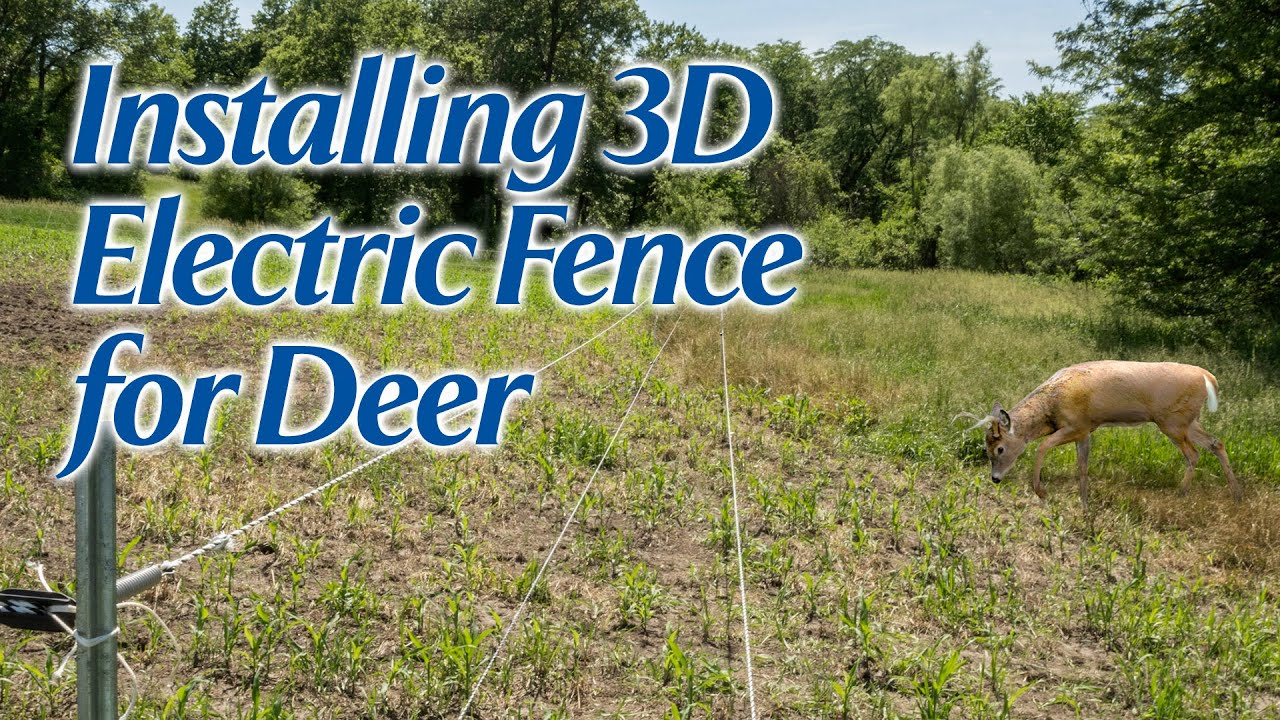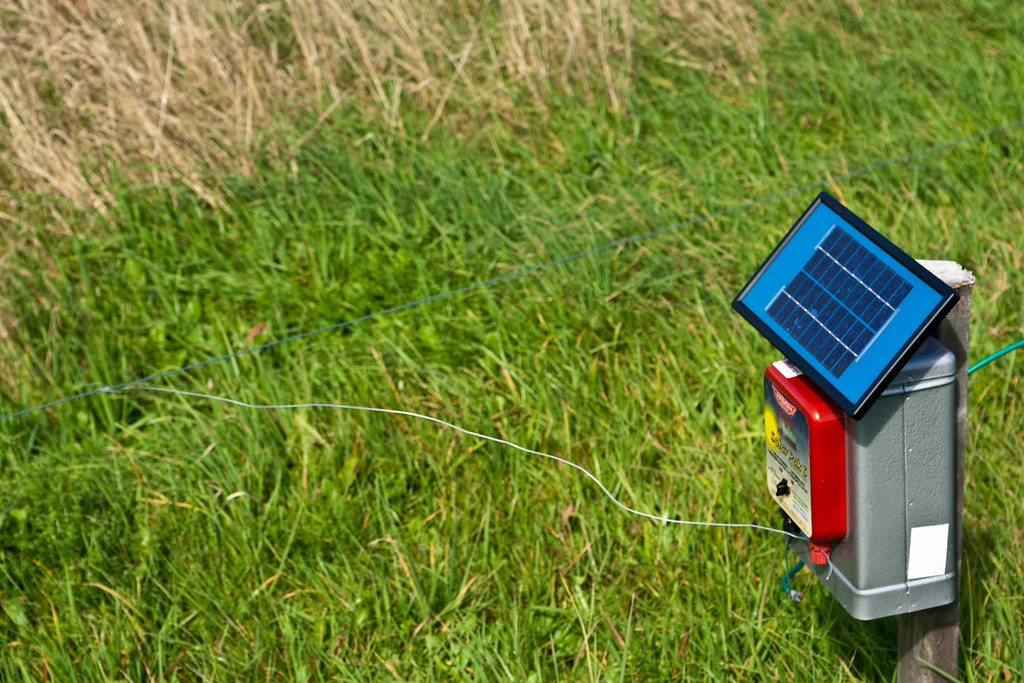In the realm of wildlife management, the solar electric deer fence stands as an innovative and sustainable solution for keeping deer at bay. Unlike traditional fencing methods, solar electric deer fences harness the power of the sun to create a safe and effective barrier that protects your property from these curious and often destructive creatures.
This comprehensive guide delves into the world of solar electric deer fences, exploring their components, benefits, applications, and installation techniques. We’ll also uncover the environmental considerations and cost-effectiveness of these fences, empowering you to make informed decisions about protecting your property and maintaining a harmonious coexistence with nature.
Solar Electric Deer Fence Overview


A solar electric deer fence is a fencing system that uses solar power to energize a wire mesh fence, creating a barrier that deters deer from entering a protected area. The system consists of a solar panel, a fence charger, a grounding system, and a wire mesh fence.
The solar panel converts sunlight into electricity, which is then stored in a battery. The fence charger uses the stored electricity to energize the wire mesh fence, creating a mild electric shock when an animal touches it. The grounding system provides a path for the electricity to flow back to the fence charger, completing the circuit.
Components and Function
- Solar Panel:Converts sunlight into electricity, which is stored in a battery.
- Battery:Stores the electricity generated by the solar panel.
- Fence Charger:Uses the stored electricity to energize the wire mesh fence.
- Grounding System:Provides a path for the electricity to flow back to the fence charger.
- Wire Mesh Fence:The physical barrier that is energized by the fence charger.
Benefits and Applications
Utilizing a solar electric deer fence offers several advantages. It is an environmentally friendly and humane method of deterring deer without harming them. The fence is powered by the sun, eliminating the need for expensive and potentially hazardous wiring. Additionally, it is relatively easy to install and maintain.
Solar electric deer fences are commonly used in a variety of applications, including:
Residential properties
- Protecting gardens, yards, and landscaping from deer damage.
Agricultural settings
- Protecting crops and livestock from deer.
Forestry
- Preventing deer from browsing on young trees.
Conservation areas
- Protecting sensitive ecosystems from deer grazing.
Design and Installation


The design and installation of a solar electric deer fence involve several key factors to ensure its effectiveness. The process typically includes selecting the appropriate materials, determining the fence layout, and following proper installation procedures.
A solar electric deer fence is a great way to keep deer out of your garden. The fence uses a low-voltage electric current to deter deer from crossing it. The current is not harmful to deer, but it is enough to make them uncomfortable.
If you are looking for a way to keep deer out of your garden, a solar electric deer fence is a good option. You can find more information about 300 blackout winchester deer season xp here.
Factors to Consider in Fence Design
- Purpose and Location:Determine the primary purpose of the fence (e.g., deer exclusion, livestock containment) and its intended location (e.g., open field, woodland).
- Deer Population:Consider the density and behavior of deer in the area to determine the height, strength, and spacing of the fence.
- Terrain:The slope, soil conditions, and presence of obstacles can influence the layout and installation methods.
- Vegetation:Identify and address potential vegetation growth that could interfere with the fence or provide cover for deer.
- Power Source:Select a solar panel and battery system that provides sufficient power to maintain an effective electrical charge on the fence.
Step-by-Step Fence Installation
- Mark the Perimeter:Determine the fence line and mark it with stakes or flags.
- Install Fence Posts:Space fence posts at regular intervals, ensuring they are securely anchored in the ground.
- Attach Wire or Cable:Run the electric wire or cable along the fence posts, using insulators to prevent electrical leakage.
- Connect Power Source:Install the solar panel and battery system and connect them to the fence.
- Test the Fence:Use a fence tester to verify that the fence is properly electrified.
- Maintain the Fence:Regularly inspect the fence for damage, vegetation growth, or other issues and make repairs as needed.
Maintenance and Troubleshooting: Solar Electric Deer Fence
Regular maintenance is crucial to ensure the effectiveness and longevity of a solar electric deer fence. This involves periodic inspections, cleaning, and component checks to maintain optimal performance.
Troubleshooting common problems is also essential for addressing any issues that may arise, ensuring the fence remains functional and provides reliable protection against deer.
Regular Maintenance
- Inspect the fence regularly:Check for any damage or breaks in the wire, posts, or insulators. Ensure the vegetation is trimmed around the fence to prevent short circuits.
- Clean the fence:Remove any dirt, debris, or vegetation that may accumulate on the fence, as this can reduce its conductivity.
- Check the solar panel and battery:Ensure the solar panel is clean and free of obstructions, and the battery is fully charged. Replace the battery if necessary.
- Test the fence:Use a fence tester to verify the voltage and continuity of the fence. Ensure the voltage is within the recommended range.
Troubleshooting Common Problems
- No voltage on the fence:Check the solar panel, battery, and wiring connections. Ensure the battery is charged and the solar panel is receiving sunlight.
- Intermittent voltage:Check for loose connections or damage to the wire or insulators. Ensure the vegetation is trimmed around the fence to prevent short circuits.
- Deer are not deterred by the fence:Increase the voltage of the fence, check for any breaks or shorts in the wire, and ensure the fence is properly grounded.
Effectiveness and Comparison
Solar electric deer fences are highly effective in deterring deer from entering protected areas. They create a psychological and physical barrier that discourages deer from crossing the fence line. The mild electric shock delivered by the fence is unpleasant enough to deter deer without causing any harm.
Compared to other deer fencing methods, solar electric fences offer several advantages. They are more cost-effective than traditional woven wire fences, as they require fewer materials and less labor to install. They are also more durable and require less maintenance, as they are not susceptible to rust or rot.
Additionally, solar electric fences are less visible than traditional fences, making them less intrusive on the landscape.
Solar electric deer fences are a great way to keep deer out of your garden. They’re easy to install and maintain, and they don’t require any chemicals. If you’re looking for a more decorative way to keep deer away, you might want to consider mackenzie childs standing deer . These beautiful deer statues are made of durable resin and are designed to look like real deer.
They’re a great way to add a touch of elegance to your garden, and they’ll also help to keep deer away from your plants. Solar electric deer fences are a great way to keep deer out of your garden, and they’re also a great way to add a touch of style to your outdoor space.
Effectiveness of Solar Electric Deer Fences
- Deer are naturally averse to electric shocks, so they will avoid crossing a fence that delivers a mild shock.
- The psychological barrier created by the fence is also effective in deterring deer, as they learn to associate the fence with an unpleasant experience.
- Solar electric fences are effective in deterring deer of all ages and sizes, including fawns and bucks.
Comparison to Other Deer Fencing Methods, Solar electric deer fence
| Fencing Method | Cost | Durability | Maintenance | Visibility |
|---|---|---|---|---|
| Woven Wire Fence | High | Moderate | High | High |
| Solar Electric Fence | Moderate | High | Low | Low |
| Plastic Mesh Fence | Low | Low | Low | High |
Environmental Considerations


Solar electric deer fences offer several environmental benefits. They eliminate the need for chemical repellents or physical barriers that can harm wildlife or disrupt natural ecosystems. Moreover, they do not produce noise or air pollution, making them an environmentally friendly alternative to traditional fencing methods.
Potential Negative Impacts
While solar electric deer fences are generally considered environmentally friendly, there are a few potential negative impacts to consider:
- Wildlife entanglement:If the fence is not properly installed or maintained, wildlife can become entangled in the wires, leading to injury or death.
- Disruption of wildlife movement:Fences can disrupt the movement of wildlife, particularly for species that rely on large home ranges or migratory patterns.
- Aesthetic concerns:Some people may find solar electric deer fences to be visually intrusive in natural areas.
Costs and Considerations


Installing and maintaining a solar electric deer fence involves several costs. These include the materials, installation, and ongoing maintenance. The materials required include the solar panels, battery, charger, fence wire, and insulators. Installation costs depend on the size of the fence and the complexity of the terrain.
Ongoing maintenance includes periodic inspections, repairs, and battery replacement.
Cost-Effectiveness
The cost-effectiveness of a solar electric deer fence depends on several factors, including the size of the area to be fenced, the local deer population, and the cost of materials and installation in your area. In areas with a high deer population, a solar electric fence can be a cost-effective solution to prevent deer damage.
However, in areas with a low deer population, the cost of the fence may outweigh the benefits.
The lifespan of a solar electric deer fence is typically 10-15 years. During this time, the fence will require periodic maintenance, such as replacing the battery and repairing any damage. The cost of maintenance will vary depending on the size and condition of the fence.
Closing Notes
As we conclude our exploration of solar electric deer fences, it’s evident that these innovative barriers offer a practical, eco-friendly, and cost-effective solution for deterring deer. Whether you’re a homeowner seeking to safeguard your garden or a farmer protecting your crops, a solar electric deer fence can provide peace of mind and preserve your property.
Remember, proper planning, installation, and maintenance are crucial to ensure the effectiveness and longevity of your solar electric deer fence. By embracing this sustainable approach to wildlife management, you can create a harmonious balance between protecting your property and respecting the natural world.
Frequently Asked Questions
How effective are solar electric deer fences?
Solar electric deer fences are highly effective in deterring deer. The mild electric shock they deliver is harmless to deer but creates an unpleasant experience that discourages them from approaching the fence.
What are the benefits of using a solar electric deer fence?
Solar electric deer fences offer numerous benefits, including being eco-friendly, cost-effective, easy to install, and low-maintenance.
How much does it cost to install a solar electric deer fence?
The cost of installing a solar electric deer fence varies depending on the size of the area to be fenced and the materials used. However, it is generally more cost-effective than traditional fencing methods.
Is it difficult to install a solar electric deer fence?
Installing a solar electric deer fence is relatively easy and can be done by following the manufacturer’s instructions. However, it is important to ensure that the fence is properly grounded and that all connections are secure.
How do I maintain a solar electric deer fence?
Maintaining a solar electric deer fence is simple and involves periodic checks of the fence line, vegetation control, and occasional battery replacement.







